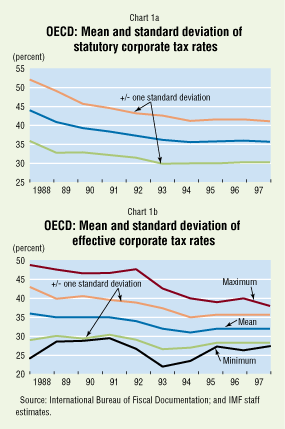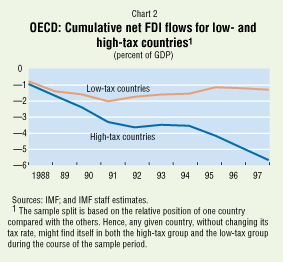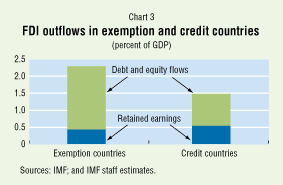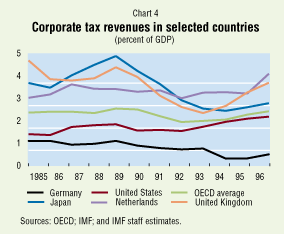 About F&D Subscribe Back Issues Write Us Copyright Information |
FDI and Corporate Tax Revenue: Tax Harmonization or Competition? Reint Gropp and Kristina Kostial OECD countries with high corporate tax rates have experienced both high net outflows of foreign direct investment and a decline in corporate tax revenue. Identification of a causal link between these two trends has implications for the debate on tax harmonization versus tax competition. Globalization and the resulting increase in capital mobility have created opportunities for potentially harmful tax competition among countries eager to attract investment. Simply by relocating mobile capital, large multinational firms can reduce their tax burden. While this practice by itself might not necessarily be harmful, the difficulty for national fiscal authorities in taxing the capital of these multinationals can result in distortions in the patterns of trade and investment. It can also result in a redistribution of the tax burden from mobile capital onto less mobile factors—in particular, labor—or from large multinationals to small national firms. Thus, the ability of large multinationals to minimize their tax liability or escape it altogether has considerable implications for countries' fiscal structure, possibly entailing more regressive tax systems, larger budget deficits, or a cut in public services. Recent trends Tax competition for foreign direct investment (FDI) can have adverse effects on corporate tax revenue. In fact, these effects may have already become evident in the sharp decline in corporate tax revenue in some member countries of the Organization for Economic Cooperation and Development (OECD). It is interesting that the countries experiencing revenue declines also offer the least attractive corporate tax regimes within the OECD. Although part of the decline can be attributed to business-cycle variations or changes in tax codes, its extent and persistence suggest that additional factors may be at work, including the direction and size of FDI flows. Although the share of FDI flows to non-OECD countries has been gradually increasing (up from about 20 percent of total flows in the 1980s to 30 percent, on average, in the 1990s), most FDI flows are within OECD countries. Since the mid-1980s, OECD countries have been harmonizing their corporate tax regimes, as evidenced by a reduction and convergence in both statutory and effective corporate tax rates. Between 1988 and 1997, the OECD average statutory corporate tax rate declined from 44 percent to 36 percent. More important, countries have converged to this rate as the dispersion around the average, measured by the standard deviation, also declined, from 8 percent to 5 percent (Chart 1a). The same trend is observed for the effective tax rate in Chart 1b, which shows that countries did not broaden their tax bases in conjunction with a rate reduction. The reduction in statutory rates with a concurrent reduction in the standard deviation in itself suggests that tax competition is important, and that governments may have redesigned their tax policies to counter the threat of FDI outflows and to attract FDI inflows.

Link between taxes and FDI Corporate tax policies pursued by one country can affect other countries in different ways. If a country's domestic tax burden is high relative to other countries, the tax base may shift to countries with a less burdensome tax regime, implying outward flows of FDI. Countries can compete to attract inward investment flows as well. Taxes may also play a major role in firms' decisions about where to declare profits. In fact, anecdotal evidence suggests that multinationals spend considerable resources on transfer pricing and other tax-planning techniques involving cross-border transactions to minimize tax liabilities. Comparing a group of countries with the lowest tax rates ("low-tax group") to a group of countries with the highest tax rates ("high-tax group"), we can document a strong link between FDI and the tax regime (Chart 2). During the sample period (1988-97), countries in the low-tax group experienced much lower net FDI outflows relative to the high-tax group; net outflows in the low-tax group were about half those in the high-tax group.

It is possible that the level of tax rates is correlated with other unobserved characteristics that make a country more or less attractive as a recipient of FDI. These may include a more business-friendly legal environment or lower overall taxes, including taxes on labor. If such correlations were indeed present (for example, if a low (high) corporate tax rate indicated a generally low (high) tax burden and a more (less) business-friendly environment), the tax effects would be overstated. To investigate this possibility, we split the sample into two groups: "credit countries," which tax worldwide income (that is, they use a credit system for foreign taxes paid—about one-third of our sample); and "exemption countries," which exempt income from foreign sources. Domestic taxes should matter more for outflows in exemption countries, because firms can escape domestic taxation entirely by investing abroad. By contrast, FDI outflows in credit countries should be less sensitive to taxes, because they cannot escape domestic taxation entirely, at least insofar as profits are eventually repatriated. In Chart 3, total FDI outflows are divided into two components: debt and equity investment and reinvested earnings of foreign subsidiaries. Firms resident in a country that asserts the right to tax worldwide income and gives a credit for only the foreign tax paid have a larger incentive to reinvest their earnings abroad (rather than repatriate them) than firms resident in a country that exempts foreign-source income. Hence, one would expect debt and equity investments to be higher in high-tax countries that exempt foreign-source income, and the earnings of firms resident in high-tax countries more likely to be reinvested in high-tax countries with a credit system; these patterns are indeed reflected in Chart 3.

How FDI affects corporate tax revenue FDI affects corporate tax revenue mostly through transfer pricing. For example, consider a multinational in a high-tax country producing a good with inputs from a branch in a low-tax country. For interfirm trade, the multinational has an incentive to overstate the price of inputs, because this increases the profits in the low-tax country and reduces the profits in the high-tax country, thus minimizing worldwide tax liabilities. Even though OECD countries have adopted transfer-pricing rules, which aim at making firms charge arm's-length prices for intrafirm trade (that is, prices at which a willing buyer and a willing, unrelated seller would freely agree to transact), transfer pricing is part of corporate reality, as evidenced by the number of thriving consultancies in this area. One can analyze this relationship by looking at individual country data (see Chart 4). Overall, after a rapid decline in corporate tax revenues during the early 1990s, the OECD average ratio of corporate tax to GDP appears to have stabilized, even though the magnitude of FDI flows has increased further. Data for individual countries, however, reveal a different trend. For example, in Japan and Germany—two countries with relatively high corporate tax rates, low FDI inflows, and high FDI outflows—the decline of corporate tax revenue appears to have been persistent. In contrast, the United States—which has been a low-tax country and a recipient of substantial FDI inflows—appears to have experienced a steady increase in corporate tax revenue. Finally, countries that attracted as much FDI as they invested abroad, like the Netherlands and the United Kingdom, have had relatively stable ratios of corporate tax to GDP.

Tax harmonization in the European Union The question of the effect of FDI on taxes, and the associated issue of tax harmonization versus tax competition, is of particular relevance in the European Union (EU), where trade is liberalized and standards are largely harmonized. Consequently, competition for the location of investment within the European Union is particularly intense and has further deepened in response to the introduction of the euro. Policymakers are currently debating whether corporate tax regimes can be allowed to compete for FDI or whether taxes should be harmonized. Some European governments fear that without harmonization, taxes could fall to levels that could jeopardize the fiscal goals set out in the Stability and Growth Pact adopted by EU countries in July 1997. To assess the impact of harmonizing corporate tax rates, we simulated FDI flows and revenue for all EU countries, assuming that they harmonized their rates at the EU-wide mean rate from 1990 onward. The simulations are based on a three-stage model, which relates tax rates to FDI, FDI to corporate profits, and corporate profits in turn to corporate tax revenue. In the simulation, we isolate the revenue impact of a change in FDI flows but do not attempt to capture the impact of the rate changes on the overall tax base. The simulation indicates that rate harmonization would have a moderate effect on the net FDI position of most countries (because of a marginal change in the rates) but a sizable effect for countries with tax rates substantially different from the EU mean (see table). The net FDI position of three countries—Germany, Ireland, and Italy—would be significantly affected: a harmonization of rates would imply large rate reductions (for Germany and Italy) or increases (for Ireland). For example, Italy would reduce its tax rate from 51 percent to 35 percent, resulting in a net FDI gain of almost 1 percentage point of GDP, moving from a net outflow position to a balance. In contrast, the Irish economy, which—partly because of its exceptionally low tax rate of 10 percent on manufacturing FDI—is the largest beneficiary of FDI inflows within the European Union, would lose more than 1.3 percentage points of GDP in FDI. |